Africa
![]()
The title of this article is ambiguous. For other meanings, see Africa (disambiguation).
Africa
.svg.png)
![]()
Africa is one of the continents of the Earth. Its area of 30.2 million km² corresponds to about 22% of the total land area of the planet, and it has a population of about 1.3 billion people (2017). This makes it the second largest continent after Asia in terms of both extent and population. Nearly all African countries are members of the United Nations and the African Union. The continent is predominantly rural and characterized by high birth rates, which are declining due to modernization. As a result of the sharp increase in urbanization since about 1950, more and more Africans live in urban areas. Some African cities are among the world's largest metropolitan areas, including Cairo, Lagos, Kinshasa, Johannesburg, Luanda and Alexandria.
According to the "Out-of-Africa-Theory" Africa is considered to be the "cradle of mankind", where in the course of hominization the development to anatomically modern man Homo sapiens took place. One of the earliest advanced civilizations of mankind formed in ancient Egypt. Over the millennia, various "great empires" developed on the continent, such as the Empire of Abyssinia. The slave trade with the African empires since the 16th century and the later colonization by European states ("Race for Africa") led to a partly drawing-board-like division of territory. This was adopted by many newly formed African states in the course of decolonization beginning in the mid-20th century. The heterogeneous peoples of Africa traditionally had different settlement areas, which contributed to various conflicts and wars over territorial, resource and power claims.
While most countries in Africa were ruled autocratically for a long time, democratic movements prevailed more frequently from the late 20th century onward, with the Africa region performing the worst since democracy measurements began. Poverty, famine, infant mortality, and health problems have been significantly reduced through education, economic, medical, and infrastructural advances in recent decades. The importance of Africa's nations in the global economy is still low by GDP, with a few exceptions such as South Africa, Nigeria, Egypt, Algeria, Angola and Morocco. However, several African countries have been among the world's fastest growing economies since the beginning of the 21st century. The continent's raw materials and arable land are of increasing importance to African countries as well as industrialized and emerging economies trading with them.
The geography and nature of Africa are diverse, there are a large number of nature protected national parks. The African UNESCO World Heritage is comprehensive.
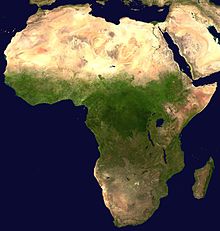
Satellite image mosaic of Africa
Etymology
In antiquity, the Latin name Africa referred only to the area of the Roman province of the same name in what is now Tunisia around Carthage. The continent (initially only North Africa west of the Nile) was often called Libya in antiquity. The name Africa was first used by the Roman senator and general Scipio Africanus and is derived from the Latin word Afer (plural: Afri), meaning "Africans, Punic", which in turn may have been derived from an indigenous tribe. Other variants of interpretation related the folk name Afer to the Hebrew ʿafar ("dust"), the Greek aphrike ("uncold"), or the Latin aprica ("sunny").
Geography
Africa is surrounded by the Mediterranean Sea in the north, the Atlantic Ocean in the west, and the Indian Ocean and the Red Sea in the east. The length of its coastline is 30,490 km, which is relatively small compared to its large area. The only land connection with other mainland masses is with Eurasia at the site of the Sinai Peninsula, which lies between Africa and the Arabian Peninsula. Europe is closest to Africa at the Strait of Gibraltar and the Strait of Sicily. The southernmost point of Africa is Cape Agulhas at 34°50' South. The African continent is only slightly indented; it has fewer islands and peninsulas than any other continent.
Due to its location on both sides of the equator and its compact shape, Africa has the largest contiguous land mass in the tropics. 75% of Africa's area lies within the tropics, which form the mathematical tropical boundary. Much of central and western Africa is covered by tropical rainforest; the Congo Basin is the second largest rainforest area on earth after Amazonia. Around the tropics, large deserts have developed and are spreading by desertification; the Sahara in the north is interrupted only by the river oasis of the Nile; in the south are the Namib as a cloud desert and the Kalahari as a dry savannah. South of the Sahara (Sahel) and in East Africa down to South Africa there are huge savannah areas. In the area of two annual rainfall maxima, the dry forests and fire ecosystems spread, for example mopane, miombo or chipya vegetation. Southeast Africa is more fertile due to the influence of the monsoon and the large valleys of the Zambezi and Limpopo rivers.
The smallest state on the mainland, Gambia, is about the size of Cyprus, and the largest, Algeria, is about seven times the size of Germany. The largest island is Madagascar, which lies off the southeast coast of Africa in the Indian Ocean.
See also: Geography of Africa and Deserts of Africa
Outline
The following division of Africa into regions is used, among others, by the UN statistical agency UNSD:
- North Africa
- West Africa
- Central Africa
- East Africa
- Southern Africa (named differently from the other regions to distinguish it from the state of South Africa)
Waters
Still waters
→ Main article: African Great Lakes
There are two basic types of lakes. One is the basin lakes, which are shallow and wide and change their size a lot due to evaporation. An example of this is Lake Chad. The other is the rift lakes, which are located in the East and Central African Rift and are very deep, long and narrow. Examples are Lake Malawi or Lake Tanganyika.
Running waters
There are also two types of rivers in Africa, one feeds basin lakes, they do not have a large gradient and have a low flow velocity, for example the Shari, which feeds Lake Chad, or the Okavango, which seeps and evaporates in the Okavango Delta. On the other hand, there are the rivers that flow into the sea, they have a high gradient and therefore a high flow velocity, examples are the Nile, which flows into the Mediterranean Sea, Niger, Congo and Orange, which flow into the South Atlantic Ocean, or the Zambezi, which flows into the Indian Ocean.
- The longest river of Africa and at the same time the longest or second longest river of the earth, because the length of the Amazon - depending on the definition - is given between 6500 kilometers and 6800 kilometers, is the Nile with 6671 km. It flows into the Mediterranean Sea.
- At the headwaters of the Nile lies Lake Victoria (68,870 km²), the largest lake in Africa and the third largest lake on earth in terms of area after the Caspian Sea and Lake Superior.
- The second longest river in Africa and the continent's most water-rich is the Congo with 4374 km. It flows into the South Atlantic.
- A right tributary of the Congo is the approximately 350 km long Lukuga, the only outflow of the East African Lake Tanganyika. At 1470 m, this is the second deepest lake in the world after Lake Baikal.
- The Niger is the third longest river or stream in Africa after the Nile and the Congo, with a length of 4184 km. After leaving the Kainji reservoir, the Niger flows into the South Atlantic. Its catchment area is 2,261,763 km².
- At 2736 km, the Zambezi is the fourth longest river in Africa and the largest African river flowing into the Indian Ocean. The catchment area covers 1,332,574 km², which is about half of the Nile catchment area.
- Lake Malawi, with 29,600 km², is one of the deepest lakes in Africa with 706 m. Its outflow is the Shire River, which flows into the Zambezi after 402 km.
Groundwater
The groundwater map of Africa published by the British Geological Survey (BGS) shows that in most populated areas, water could even be pumped to the surface using hand pumps.
Mountains and mountains
In northwestern Africa, the geologically young Atlas or Maghreb Mountains run through the states of Morocco, Algeria, and Tunisia. Together with the Alps, they were formed as the African and Eurasian plates converged.
Running through eastern Africa is the Great African Rift Valley, which is the continuation of the rift valley under the Red Sea and indicates a split of the Horn of Africa and Arabia from the rest of Africa. The resulting volcanism created, among other things, the Kilimanjaro massif, the highest mountain massif in Africa, the Rwenzori Mountains, and the Mount Kenya massif. Further along the rift valley are Lake Turkana, Lake Kivu, Lake Tanganyika and Lake Malawi, as well as the lower reaches of the Zambezi River.
| The five highest mountains or mountain massifs with their respective highest mountain | |||
| Mountains | Mountain | Height | State |
| Kilimanjaro Massif | Kibo (Uhuru Peak) | 5895 m | Tanzania |
| Mount Kenya Massif | Batian | 5199 m | Kenya |
| Rwenzori Mountains | Margherita Peak | 5109 m | DR Congo and Uganda |
| Abyssinia highlands | Ras Dashen | 4533 m | Ethiopia |
| Virunga Volcanoes | Karisimbi | 4507 m | Rwanda, DR Congo and Uganda |
In addition, the Atlas Mountains with Toubkal (4165 m) in Morocco, Mount Meru (4562.13 m), an inselberg in Tanzania, and Mount Cameroon (4095 m), an inselberg in Cameroon, are among the highest mountains, massifs, and mountains, respectively, on the continent.
Climate
The climates of Africa range from ever-humid tropical to cold Afro-alpine on the highest peaks. The northern half of Africa and the extreme southwest consist mainly of deserts with arid climates, while it becomes increasingly humid toward the equator. Africa is the hottest continent on earth, and its land area is the only part of the world to encompass the entire northern and southern tropical zones. Almost 60% of the total land surface consists of drylands and deserts. The record for the highest temperature ever recorded, in Libya in 1922 (58 °C), was discredited in 2013.
_(W3).svg.png)
Africa's position in the world

Virunga volcanoes landscape
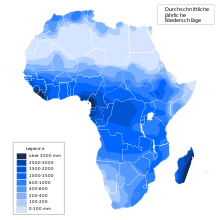
Precipitation map of Africa

Regions of Africa: "" North Africa "" West Africa "" Central Africa "" East Africa "" Southern Africa
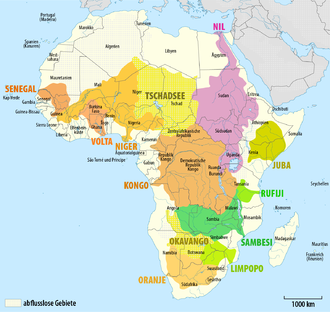
Catchment areas of the major water systems in Africa
Geology
Most of Africa consists of very old (Precambrian) platforms, mostly covered by younger sediments of the Karoo Supergroup.
Geologically, the Arabian Plate belongs to Africa, with Africa being bounded to the northeast by the Taurus Mountains in southern Turkey and the Zāgros Mountains in western Iran.
See also: Africides
Vegetation and wildlife
The most important vegetation areas of the African continent are on the one hand the rainforests of West and Central Africa, on the other hand the three large desert areas and thirdly the savannah and dry forest areas lying in between. The central African rainforest block in the area of the Congo Basin is isolated from the rainforests on the southern coast of West Africa. The three most important deserts or semi-deserts are the Namib in the south, the Sahara in the north and the semi-desert areas in the Horn of Africa, which, however, are connected to the Sahara. Within the savannahs, a distinction is usually made between wet savannah-forest mosaics and dry savannahs, which in turn are separated by extensive forest savannahs. These forest savannas are called miombo in the southeast and doka in the northwest. North of the Sahara, Mediterranean vegetation forms also occur. Typical high mountain vegetation is found in North Africa in the Atlas Mountains, in the Ethiopian highlands, and especially in numerous, partly isolated mountain massifs of East Africa, such as Kilimanjaro, Mount Kenya Massif and Ruwenzori Mountains. A special feature is the Cape area, which is notable for its particular species richness and represents a floral kingdom in its own right. Another special form of vegetation are the South African Karoo steppes.
Africa is home to two zoogeographicalregions. The Afrotropical region, which covers the entire continent south of the Sahara, covers most of it, while the parts north of the Sahara are assigned to the Palaearctic region. This is due to numerous species of North Africa that also occur in Europe and North Asia or have close relatives there. These include the Barbary deer (a subspecies of the red deer) and the now extinct Atlas bear. The fauna of Africa, especially south of the Sahara, is characterized above all by a great species richness of large mammals. The largest land mammal species on the continent are the African elephant and forest elephant, hippopotamus and rhinoceros. Other typical large animals include Cape buffalo, giraffes, zebras, numerous antelope and duiker species, and various pigs. In the area of the Danakil Desert, there are also remaining populations of the African wild ass, and in the mountains of North Africa, ibex and maned sheep. Large predators are also abundantly represented by lions, leopards, cheetahs, hyenas and wild dogs. Smaller predators are represented by the aardwolf, various creeping cats, mongooses, cats, foxes, jackals, and some martens, such as the honey badger. In particular, the Central African forest areas are home to a wide variety of different primate species. These include gorillas, chimpanzees, guenons, galagos and pottos. Typically African orders of mammals include aardvarks, shags, proboscideans, otter shrews, and golden moles, all of which belong to the Afrotheria group. This group of animals also includes the elephants and manatees such as the African manatee and dugong and originated in Africa. Widespread mammalian orders also found in Africa include bats, insectivores, rodents, and hares. Pangolins are found in South Asia in addition to Africa. The largest reptile on the continent is the Nile crocodile, and the largest bird is the African ostrich.
The large animal fauna of the African savannahs is increasingly limited to individual protected areas. The best known of these, such as the Serengeti, the Chobe National Park or the Kruger National Park, are located in the eastern and southern parts of the continent. The habitats of the rainforest dwellers are also in decline.

Vegetation areas of Africa: dark green tropical rainforests; reddish: deserts and semi-deserts, lighter shades of green: savannahs; purple: Mediterranean vegetation (for legend see world map vegetation)
.jpg)
Lions
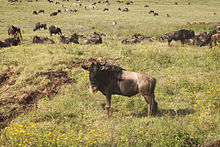
Africa is known for its large herds of wild animals, here wildebeest
Population
Development of Africa's population (in millions)
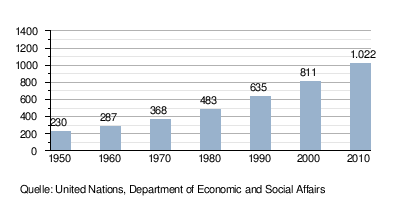
Africa has about 1.257 billion inhabitants (as of 2017), most of whom live south of the largely uninhabited Sahara desert in sub-Saharan Africa. In North Africa, where mainly Berbers and Arabs live, there are about 210 million inhabitants. For 2050, the UN expects 2.5 billion and for 2100 about 4.4 billion inhabitants.
The most populous state is Nigeria with over 200 million inhabitants. The least populous state is the Seychelles with 80,000 inhabitants.
Africa's largest city is Cairo (Egypt), with a population of about 15.7 million, followed by Lagos (Nigeria) with 14.3 million; the continent's third-largest city is Kinshasa (Democratic Republic of Congo), with 11.5 million inhabitants.
See also: List of the largest cities in Africa
Peoples
In northern Africa, Berber peoples lived for millennia before the arrival of the Arabs around the 7th century. Since then, they have lived mainly in the mountainous regions of the Maghreb, where they found refuge from the Arab invaders, but in the course of the following centuries they mixed significantly with them and created their own Maghrebi culture, which has some differences from the rest of the Arab world, for example in the language. The peoples of northeast Africa, such as the Amhars, are also Semitic peoples. The Sahara is inhabited by nomadic Tuareg.
In West Africa, the Mande and Gur peoples are worth mentioning. Hausa and Yoruba live in eastern West Africa, Wolof and Fulbe in the western part.
Central and East Africa are home to the Bantu, a group consisting of numerous peoples. The Khoisan peoples in southern Africa are among the indigenous peoples, as are the aforementioned Berbers and Tuareg in the Sahara and the Masai in East Africa. The largest group of people who migrated in the course of colonization are the Boers in South Africa. Modern migration movements have brought Lebanese to West Africa and Indians and Chinese to East Africa.
See also: Indigenous Peoples of Africa
Languages
→ Main article: African languages
In total, there are over 2000 distinct African languages, of which about 50 are considered major languages, each spoken by over one million people. Some of the major African languages are Swahili, Igbo, Hausa, and Fulfulde. English, French and Portuguese are common official and lingua franca languages in many African countries, as they greatly facilitate communication with the many minor languages. German is also still spoken in Namibia and enjoys special status in South Africa.
Afro-Asiatic languages include Arabic, Hausa, Amharic, and Oromic; Niger-Congo languages include Bambara, Swahili, Wolof, Yoruba, and Zulu. The Khoisan languages are spoken by the peoples of the same name in Southern Africa; they are characterized by click sounds. Austronesianlanguages such as Malagasy, Howa (dialect of Merina), and other Merina dialects are spoken in Madagascar.
See also: List of African languages
Religion
→ Main article: Religion in Africa and African religions
Islam is widespread in North Africa, East Africa and West Africa. According to the German Foreign Office, 44.2% of all Africans (including Arabs and Berbers in North Africa) belong to Islam, and 43.4% according to the CIA World Factbook. In addition, there are large numbers of people who practice traditional religions, especially in West and Southeast Africa. It is estimated that these are 13 to 20 % of Africans. The remaining 38 to 43 % belong to Christian denominations. The majority of African Christians live in southern Africa. The Ethiopian Orthodox Tewahedo Church plays a special role, since in Ethiopia the Kingdom of Aksum made Christianity the state religion. Bahai, Judaism and Hinduism are also widespread among the non-African minorities.
Health and health care
The average life expectancy of an African woman is 61.9 years, and the average life expectancy of an African man is 58.6 years. This is far lower than on other continents (period 2010-2015). Africa is also the continent most affected by HIV/AIDS. About 4% of the population is HIV-positive (see also: HIV/AIDS in Africa). Since around 2005, however, progress has been made in the fight against the epidemic, which is why average life expectancy is rising again in almost all countries in Africa.
| Development of life expectancy in Africa (Source: UN) | |||
| Period | Life expectancy | Period | Life expectancy |
| 1950–1955 | 37,5 | 1985–1990 | 51,7 |
| 1955–1960 | 40,0 | 1990–1995 | 51,7 |
| 1960–1965 | 42,3 | 1995–2000 | 52,3 |
| 1965–1970 | 44,4 | 2000–2005 | 53,7 |
| 1970–1975 | 46,6 | 2005–2010 | 57,0 |
| 1975–1980 | 48,7 | 2010–2015 | 60,2 |
| 1980–1985 | 50,5 | 2015–2020 | 62,4 |
African countries initially responded to the spread of coronavirus in 2020 in varying ways and intensities. Egypt, Algeria, Morocco and South Africa were particularly hard hit in the first quarter of the year. The African Union, through its Africa Centres for Disease Control and Prevention - Africa CDC substructure, supports member countries in their response to the threat of infection with COVID-19. Regional Collaborating Centres (RCCs) exist for North Africa (Cairo, Egypt), East Africa (Nairobi, Kenya), Southern Africa (Lusaka, Zambia), West Africa (Abuja, Nigeria) and Central Africa (Libreville, Gabon).
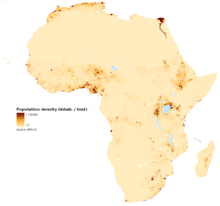
Population density in Africa (2005)
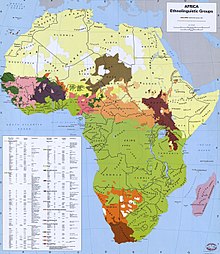
Ethnolinguistic groups of Africa (data from 1959)
History
→ Main article: History of Africa and History of North Africa
The oldest known traces of human life were found in Africa. It is considered certain that from here first Homo erectus and later - the anatomically modern man (Homo sapiens), which developed from the remaining populations of Homo erectus in Africa, spread to Asia and Europe. Accordingly, the oldest stone tools were discovered in Africa: the simple Oldowan tools of the "Early Stone Age", which in Europe is called the Old Paleolithic.
Egypt, one of the first advanced civilizations, was located in the Nile Valley in North Africa. There were also other kingdoms in West Africa, such as the Ashanti and the Haussa, but these arose much later. There were also some important cultures in East and South Africa, as well as in the area of today's Sudan, then called Nubia or Kush. Nubian pharaohs also ruled all of Egypt for one dynasty. Important cultures in southern Africa were, for example, the inhabitants of Greater Zimbabwe. This stone castle was architecturally a masterpiece for the time and significant for trade between the peoples of the south and the east. In eastern Africa, the Swahili were well known.
North Africa was connected rather than separated from Europe and the Near East by the Mediterranean Sea. Carthage, a Phoenician foundation in what is now Tunisia, was the ruling great power in the western Mediterranean around the middle of the 1st millennium BC until it was replaced by Rome in the Punic Wars. The latter ruled over all of North Africa from 30 BC (conquest of Egypt).
Already the old Egyptians (queen Hatschepsut) undertook journeys to Punt, probably in today's Somalia. The empire of the Queen of Sheba, which probably had its center in southern Arabia, is also said to have extended over parts of the Horn of Africa to northern Ethiopia. The rulers of Ethiopia traced their lineage back to the Queen of Sheba. Herodotus reports that around 600 BC, Phoenician sailors commissioned by Pharaoh Necho circumnavigated Africa from the Red Sea to the mouth of the Nile in three years. Since he reports that they claimed to have seen the sun "on their right", i.e. in the north, this report is considered credible. Certain is the voyage of the Carthaginian admiral Hanno around 500 BC, who came from southern Spain at least to Sierra Leone.
During the Migration Period, the Vandals conquered Roman North Africa from Morocco to Libya. Even before the Hijra, Arab tribes migrated to North Africa. With the triumph of Islam, Egypt was conquered in 641, Morocco in 670. In the following centuries, North Africa was almost completely Islamized, the Sahel, West and East Africa at least partially.
In 1250, the Sixth Crusade was directed against Egypt (the other crusades were directed against Palestine). Between the 9th and 16th centuries, several powerful, independent kingdoms developed in what is now Mali. In the 15th century, the west coast of Africa was explored from Portugal. Portugal and Spain established their first bases on the north coast in the 15th and 16th centuries.
After the discovery of the Americas, Africa was of interest to Europeans mainly as a source of slaves. A significant proportion of the population of Brazil, Haiti and other islands of the Caribbean, but also of the USA, are of African descent. Forts were built on the coasts for the purpose of the slave trade, and transportation from inland was usually handled by native kingdoms. Arab traders were predominant in the East African slave trade until the 17th century. The interior of the continent was largely unknown to Europeans. The first voyages of exploration were undertaken at the end of the 18th century by men of various nationalities sent out by the Association for Promotion the Discovery of the Interior of Africa (Africa Association, London).
After the Industrial Revolution and the prohibition of the slave trade in 1807, Africa became rather uninteresting. It was not until the rise of imperialism that the interest of the major European powers in the Dark Continent grew, and the race for Africa led to the occupation of almost the entire continent within less than 20 years. At the Congo Conference in Berlin in 1884/85, most of Inner Africa was divided between the European powers, and by 1912 most African peoples had lost their freedom. Only Liberia, a settlement colony of freed North American slaves, and the old empire of Abyssinia (now Ethiopia) remained independent, though it was attacked by fascist Italy in 1935 and annexed by it from 1936 to 1941. In World War I, the German colonies were theaters of war, and many Africans also fought in Europe. In World War II, fighting took place mainly in North Africa and the Horn of Africa.
In the course of Africa's decolonization, several states became independent in the 1950s. 1960 is considered the year of African independence, as most of the French colonies were released into independence in that year. Djibouti was the last state to break away from European foreign rule, in 1977. In South Africa, the black majority has only been in government since 1994. Four years earlier, the South African occupation of Namibia ended. Some islands and the areas around the cities of Ceuta and Melilla still belong to various European states.
The arbitrary demarcations of the colonial era, which disregarded historical and ethno-cultural conditions, made it difficult for most African states to develop a sense of national identity. This and the one-sided orientation of the economies toward export goods led, among other things, to an unstable political situation in most states and the prevalence of authoritarian regimes. As a result, a large part of the continent's natural wealth falls victim to corruption or is siphoned off by international corporations. Combined with underdeveloped infrastructure, climatic problems, high population growth and, in recent times, very high AIDS rates, this means that almost all of Africa belongs to the Third World. With Agenda 2063, the African Union agreed in the 2010s to implement specific goals to remove major barriers to development and thereby create prosperity for the African people by 2063. China's development financing for Africa began in the decade before that.
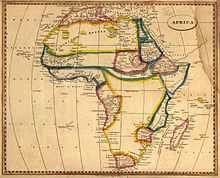
Africa from a European point of view, around 1812
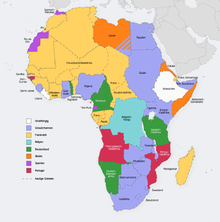
Colonization of Africa around 1914

"Lucy", the skeleton of an Australopithecus afarensis
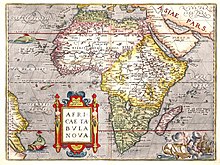
Africa from a European point of view, around 1570
States of Africa and dependent territories
→ Main article: List of states of Africa
The political organization "African Union" originally comprised 52 states on the continent; South Sudan joined in 2011 and Morocco in 2017. However, while the Sahrawi Arab Democratic Republic does not exist de facto (the Western Sahara territory is occupied by Morocco) but has been recognized by the AU as a full member, a continuous and de facto independent Republic of Somaliland has existed since 1991 but is not formally recognized.
Recognized status is thus currently held by 55 African states (all African UN member states, plus Western Sahara), one is disputed (Somaliland), and eight smaller coastal sections and island groups are under European government sovereignty, but some are also claimed by African governments.
Algeria, the Democratic Republic of Congo, and Sudan, in that order, are the countries with the largest land areas; Nigeria, with about 214 million, Ethiopia, with 108 million, and Egypt, with 104 million, are the most populous countries (as of 2020).
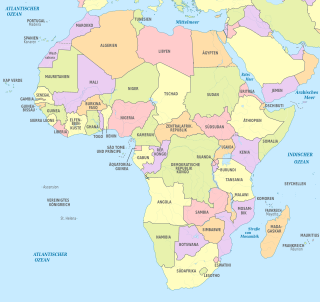
Imágenes principales Africa states
Economy and infrastructure
Economy
→ Main article: Economy of Africa
Large parts of the economy in central and southern Africa are geared to exports (for example, banana plantations, tropical timber, gold and diamond mines, cocoa plantations). In addition, there are larger industrial and smaller craft enterprises in the cities that produce for their own needs, among other things. In rural areas, subsistence farming often prevails, such as the cultivation of cassava and batata, fishing, and animal husbandry. In addition, tourism is an important source of income in some areas (for example, safaris).
In the states of North Africa, it is primarily the extraction of oil and natural gas that brings in revenue. In addition, there is agriculture along the Nile and in some fertile areas. The Nile dams are used to generate electricity. For some years now, several initiatives ("Africa Renewable Energy Initiative" (AREI), "Énergies pour l'Afrique," "Power Africa" and others) have been underway to electrify Africa.
Export article
- Cocoa: about 70% world market share
- Diamonds: about 50% world market share
- Gold: about 25% world market share
- Crude oil: about 10 % world market share
Infrastructure
Road traffic
The density of the road network is 6.84 km per 100 km².
Rail transport
The railroad lines in Africa are poorly interconnected, especially in West and Central Africa. The countries of Burundi, Cape Verde, Comoros, Gambia, Guinea-Bissau, Equatorial Guinea, Libya, Mauritius, Niger, Central African Republic, Rwanda, São Tomé and Príncipe, Seychelles, Sierra Leone, Somalia and Chad have no rail network at all.
Air traffic
Only three of Africa's airports are ranked among the world's top 150 by passenger volume.
See also: List of the largest airlines in Africa
Shipping
African ships are about 80% older than 15 years.
Agriculture
Most of the food production for the population is done through subsistence agriculture. Biodiversity is usually preserved or even promoted by this, since it is done on a very small scale and there is no money for chemical fertilizers and plant protection. In contrast, industrial agriculture has been driven by foreign corporations in recent years. These buy or lease large areas of land in order to either grow food for their own country's needs (especially the Gulf States) with high inputs of irrigation, mineral fertilizers and pesticides - or to grow crops such as sugar cane or oil palms to produce biofuel for Europe. This development is also known as land grabbing. The heads of state of many African countries are quite interested in these foreign investments, since part of them also flows into the state coffers. The fact that the large fertile land areas are no longer available for the self-sufficiency of the population is not taken into account. The following is a list of the land purchases or leases known at the beginning of 2010:
- 00,600,000 hectares leased in Ethiopia, Ethiopian government seeks leaseholders for another 3 million hectares.
- 00,100.000 hectares leased by Libya in Mali
- 00,400.000 hectares leased by a New York investment fund in Sudan.
- 02.800.000 hectares leased by China in the Democratic Republic of Congo
- 10,000,000 hectares was offered to South African large-scale farmers in the Republic of Congo
On the one hand, an African Green Revolution is proposed for the further development of agriculture in Africa: with high-yielding varieties and high use of pesticides and fertilizers, foreign know-how and modern information and financial technology to minimize risks. In contrast, Hans-Heinrich Bass argues for a Green Renaissance "that takes African farmers' know-how seriously - and merges it with contemporary knowledge."

Shares of Economic Sectors in the GDP of African Countries in 2004 and 2011

Average annual growth rates of African countries from 2001 to 2012
Organizations
Political organizations
- African Union (AU, formerly OAU)
Economic organizations
- Central African Economic and Monetary Community
- West African Economic and Monetary Union
- West African Economic Community
- South African Development Community
- Common Market for Eastern and Southern Africa
- East African Community
Other
- CAF African Football Confederation
See also
![]()
Portal: Africa - Overview of Wikipedia content on Africa
- Ethiopian, North, Black, South African Cuisine
- African culture
- African studies in the German-speaking world
- Judaism in Africa
- List of geographical records in Africa
- List of universities in Africa
Questions and Answers
Q: What is Africa?
A: Africa is the second largest continent in the world, making up about a fifth of the world's land.
Q: How many fully recognised and independent countries are there in Africa?
A: There are 54 fully recognised and independent countries in Africa.
Q: What percentage of the world's population lives in Africa?
A: 14.7% (1.216 billion) of the world's population lives in Africa.
Q: Is Africa surrounded by land or water?
A: Africa is surrounded by large areas of water.
Q: Which continent is believed to be the place where the first humans evolved?
A: Africa is believed to be the continent where the first humans evolved.
Q: What is the size of Africa compared to the rest of the world's land?
A: Africa makes up about a fifth of the world's land.
Q: How does Africa compare to other continents in terms of land size?
A: Africa is the second largest continent in the world, after Asia, in terms of land size.
Search within the encyclopedia